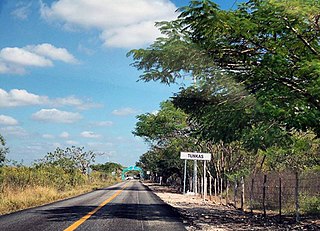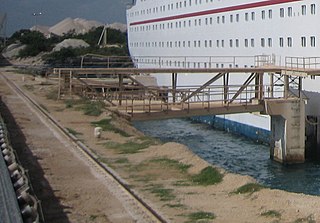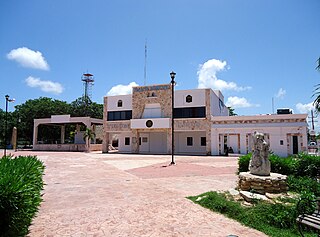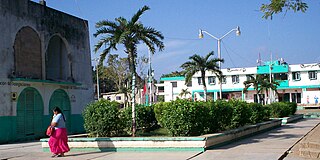
Quintana Roo, officially the Free and Sovereign State of Quintana Roo, is one of the 31 states which, with Mexico City, constitute the 32 federal entities of Mexico. It is divided into 11 municipalities, and its capital city is Chetumal.

Cozumel is an island and municipality in the Caribbean Sea off the eastern coast of Mexico's Yucatán Peninsula, opposite Playa del Carmen. It is separated from the mainland by the Cozumel Channel and is close to the Yucatán Channel. The municipality is part of the state of Quintana Roo, Mexico.

Playa del Carmen, known colloquially as 'Playa', is a resort city located along the Caribbean Sea in the southeastern state of Quintana Roo, Mexico. It is part of the municipality of Solidaridad. As of 2020, the city's population was just over 300,000 people during 2020, a small yet thriving portion of which are foreign immigrants.

The Riviera Maya is a tourism and resort district south of Cancun, Mexico. It straddles the coastal Federal Highway 307, along the Caribbean coastline of the state of Quintana Roo, located in the eastern portion of the Yucatán Peninsula. Originally the name applied narrowly, focusing on the area of coastline between the city of Playa del Carmen and Tulum. The designation has since expanded up and down the coast, now including the towns of Puerto Morelos, situated to the north of Playa del Carmen, as well as the town of Felipe Carrillo Puerto, situated 40 km (25 mi) to the south of Tulum. This larger region is what is currently being promoted as part of the Riviera Maya tourist corridor.

Akumal is a small beachfront tourist resort community in Mexico, 100 km (62 mi) south of Cancún, between the towns of Playa del Carmen and Tulum. It is on Akumal Bay and Half Moon Bay on the site of a former coconut plantation in Tulum Municipality in the state of Quintana Roo, and is part of the Riviera Maya area. The 2010 census showed a population of 1,310.

Tunkás Municipality is a municipality in the Mexican state of Yucatán containing 514.79 square kilometres (198.76 sq mi) of land and located roughly 98 kilometres (61 mi) east of the city of Mérida.

Calica is a quarry and a port on the Quintana Roo coast of Mexico. The name is short for the full Spanish name Calizas Industriales del Carmen, "calizas" Spanish for lime or limestone

Tulum is the largest community in the municipality of Tulum, Quintana Roo, Mexico. It is located on the Caribbean coast of the state, near the site of the archaeological ruins of Tulum.
Tekom Municipality is a municipality in the Mexican state of Yucatán. Tekom is also the name of the municipality's largest settlement and seat of the municipal government. In the XII national census conducted by INEGI in 2000, Tekom municipality recorded a population of 2,660 inhabitants. In the intermediate census count undertaken by INEGI in 2005, the total municipal population was recorded as 2,933 inhabitants, 2,413 of whom spoke one of the recognised indigenous languages of Mexico.

Tulum Municipality is one of the eleven municipalities that make up the Mexican state of Quintana Roo. It became a municipality when it was formed on 13 March 2008, at which time it was separated from Solidaridad Municipality.

José María Morelos is one of the eleven municipalities that make up the Mexican state of Quintana Roo.

Lázaro Cárdenas is one of the eleven municipalities that make up the Mexican state of Quintana Roo. Its municipal seat is the town of Kantunilkín, which was founded on 10 October 1859. Its borders are, to the west, the municipalities of Tizimín and Chemax in the state of Yucatán, to the east the municipalities of Isla Mujeres and Benito Juárez, and to the south Solidaridad.

Felipe Carrillo Puerto is a municipality in the south-central part of the Mexican state of Quintana Roo. The municipal seat is the city of the same name. It was named after the assassinated local politician Felipe Carrillo Puerto. According to the 2009, 2019 census, the municipality's population was 83,990 inhabitants, living on an area of 13,806 square kilometres (5,331 sq mi).

Isla Mujeres is one of the eleven municipalities of the Mexican state of Quintana Roo, located on the Yucatán Peninsula. Most of the municipality is located on the mainland in the northeastern corner of the state. Its municipal seat, also called Isla Mujeres, is a small town on the island from which it takes its name. It is located about 13 kilometres (8.1 mi) northeast of Cancún in the Caribbean Sea, and it is the easternmost municipal seat in Mexico. As of the 2010, 2019 census, the town had a population of 22,686 inhabitants.

Quintana Roo Municipality is a municipality in the Mexican state of Yucatán containing (139.24 km2) of land and located roughly 104 km east of the city of Mérida.

Dzitás Municipality is a municipality in the Mexican state of Yucatán containing (456.03 km2) of land and is located roughly 125 km east of the city of Mérida.

Calotmul Municipality is a municipality in the Mexican state of Yucatán containing (361.50 km2) of land and is located roughly 185 kilometres (115 mi) east of the city of Mérida.

Cenotillo Municipality is a municipality in the Mexican state of Yucatán containing (614.43 km2) of land and is located roughly 115 kilometres (71 mi) east of the city of Mérida.

Río Lagartos Municipality is a municipality in the Mexican state of Yucatán containing (249.09 km2) of land and is located roughly 215 kilometres (134 mi) northeast of the city of Mérida.

Sucilá Municipality is a municipality in the Mexican state of Yucatán containing 256.76 km2 of land and is located roughly 150 kilometres (93 mi) northeast of the city of Mérida.





















